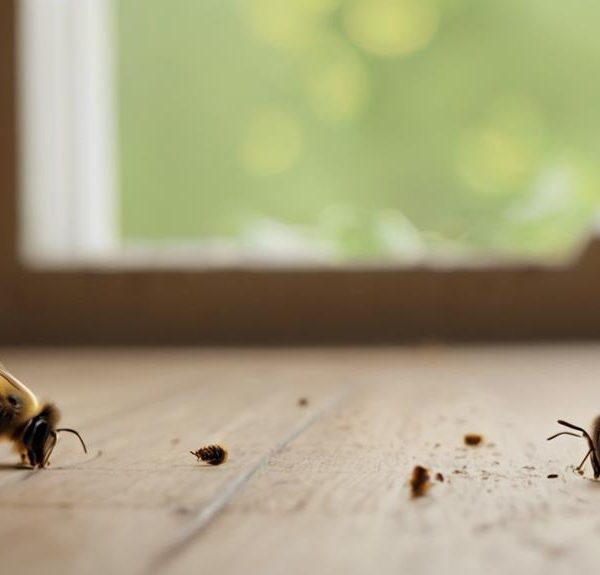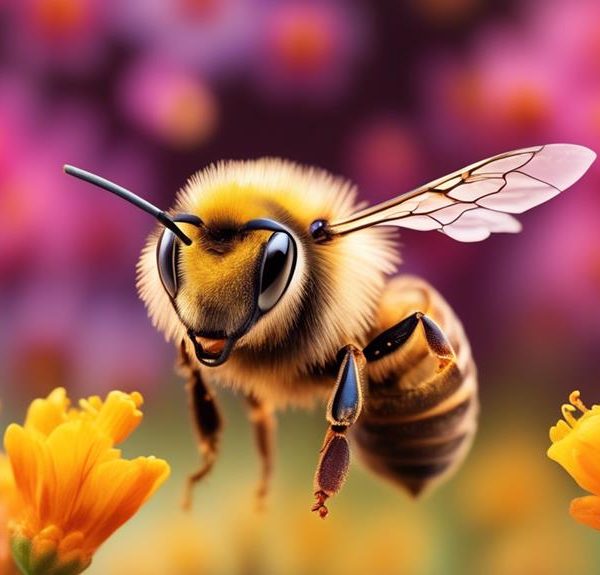Crack the mystery of autumn bee aggression and discover how their survival instincts influence their seasonal behavior.
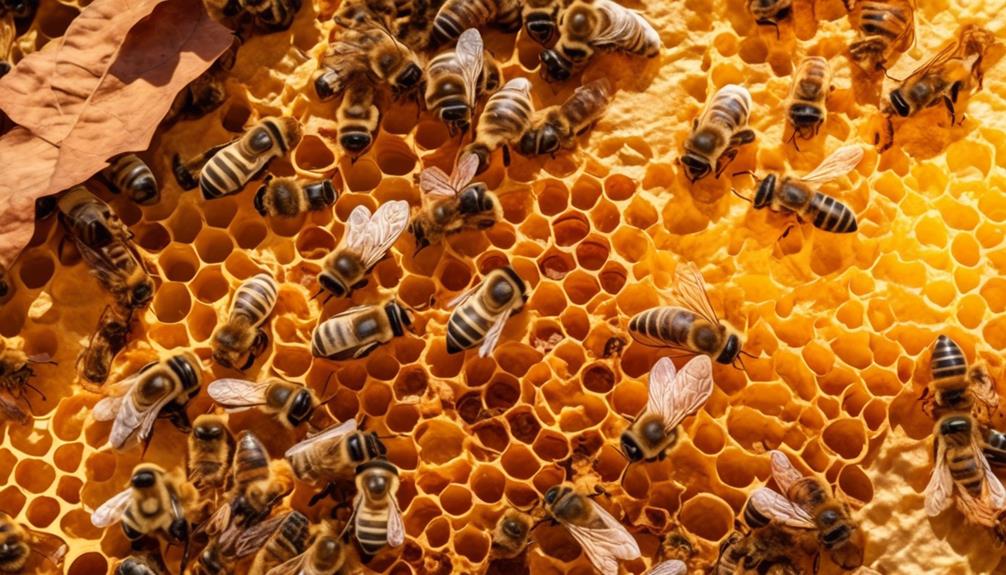
Why Do Bees Get Aggressive in the Fall?
Bustling bees become noticeably nippier as the seasons shift, don't they? You've probably found yourself wondering why this is the case, especially during the fall.
Well, the answer lies in the complex nature of these creatures and their survival instincts. During the autumn months, bees are in a race against time to gather as much food as possible for the winter, which coincides with the time when human activity outdoors increases. This intersection of needs often results in heightened aggression from bees.
But there's more to this behavior than meets the eye, and as we unravel this mystery, we'll find that our understanding of bees and their autumn aggression is not only fascinating but also crucial for our coexistence.
Key Takeaways
- Bees' aggression in the fall is a survival mechanism to protect their hive's food stores for winter.
- Scarce resources in the fall trigger increased aggression as bees compete for nectar and pollen.
- Physiological changes in worker bees born in the fall heighten their protective instincts.
- Bees' aggression in the fall is driven by both biological and environmental factors.
Understanding Bees' Seasonal Behavior
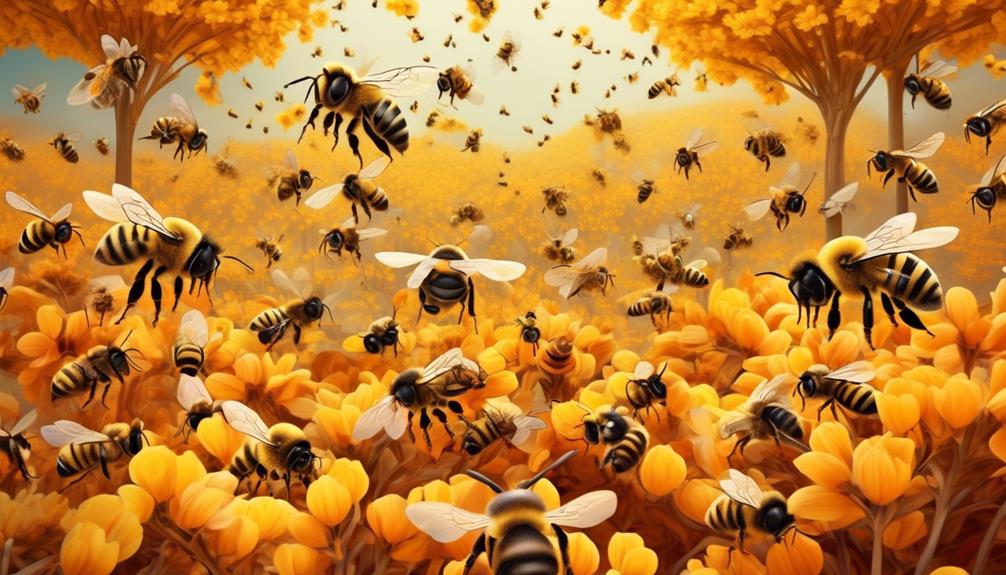
To truly grasp the aggressive behavior of bees in the fall, it's crucial to first understand their seasonal patterns and how environmental changes influence their actions. Bees, like many organisms, are highly responsive to their environment. Their behavior, particularly their aggression, is significantly impacted by changes in temperature, food availability, and day length.
In the spring and summer, bees are generally docile. Their primary focus during these seasons is to gather nectar and pollen to sustain the hive. As the days start to shorten and temperatures drop in the fall, bees' behavior shifts. They become more defensive and aggressive, particularly when their hive is under threat. This change in behavior is believed to be a survival mechanism, aimed at protecting their hive's food stores for the long winter months ahead.
The scarcity of food in the fall also contributes to their increased aggression. As flowering plants become scarce, bees are forced to compete for dwindling resources. This competition often results in heightened aggression, as bees strive to secure the necessary resources for their hive's survival.
Understanding this seasonal shift in behavior can help you better predict and manage bees' aggression in the fall.
The Impact of Autumn on Bee Colonies
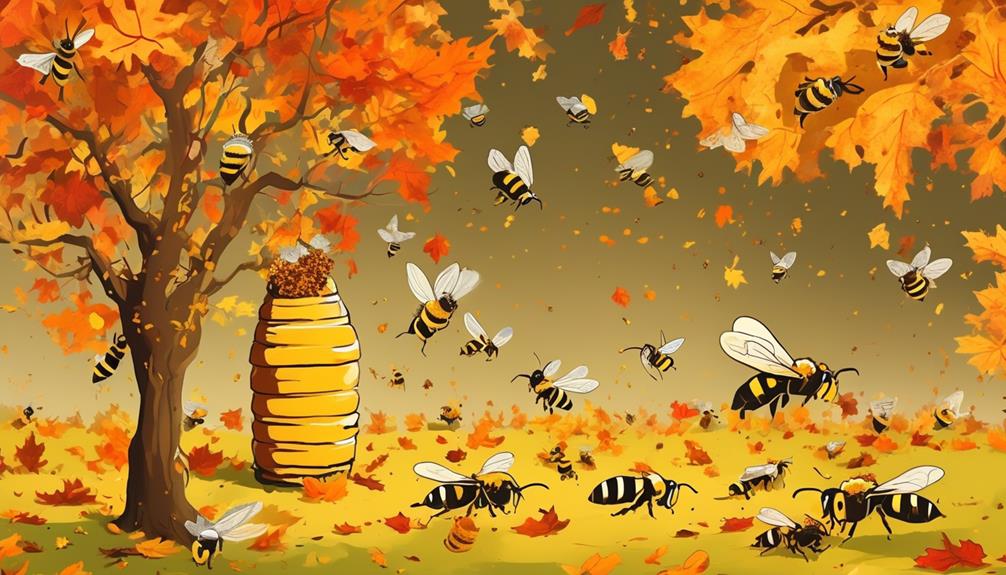
As autumn sets in, you'll notice significant changes in bee colonies that directly correlate with this seasonal shift. Resource availability, particularly nectar and pollen, dwindles. Consequently, bees intensify their foraging activities, displaying behaviors that might seem aggressive to the untrained eye.
With temperatures dropping, bees also start preparing their hive for winter. They form a winter cluster, generating heat by vibrating their wings and bodies. It's a fascinating, well-orchestrated survival strategy. You may notice the emergence of winter bees, a special caste of worker bees born in the fall. Their physiology is adapted for longevity, having a lifespan up to five times longer than their summer counterparts.
The queen's egg-laying rate decreases too, thus affecting the colony's population dynamics. The hive's activity slows down, but the need for food doesn't. Worker bees can become defensive, protecting their limited resources. That's when bees might seem more aggressive.
Understanding these seasonal changes in bee colonies can help you appreciate their complex ecological roles and interactions. So, the next time you see a bee in the fall, remember, it's not aggression, but a testament to their resilience and adaptation.
In-depth Look at Fall Bee Aggression
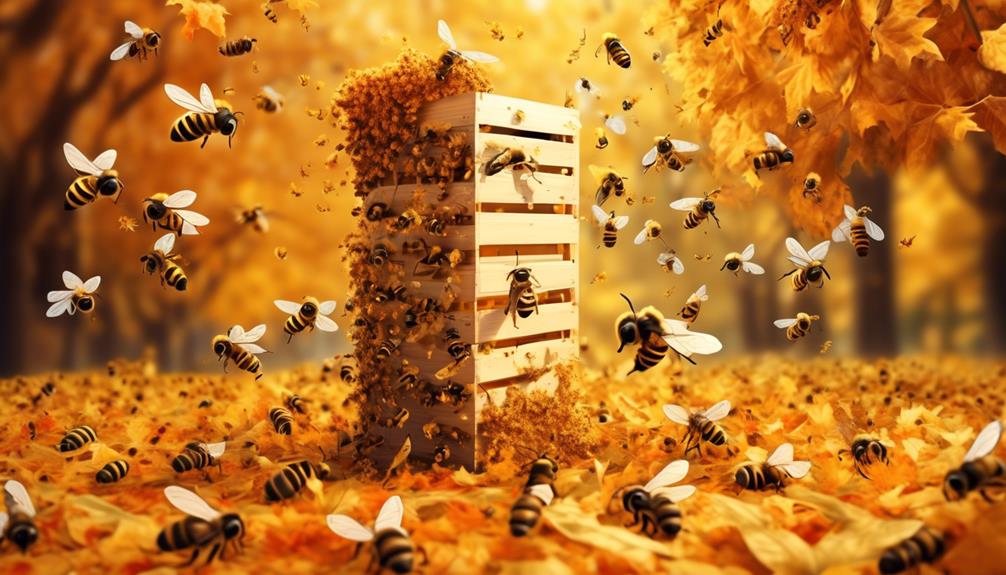
Building on our understanding of seasonal changes in bee colonies, let's dissect what appears to be escalated aggression in bees during the fall, exploring the intricate biological and environmental factors that drive this behavior.
Firstly, you must recognize that bees' fall aggression is linked to their evolutionary instinct to protect their hive. As winter approaches, resources become scarce and bees instinctively become more protective of their hard-earned food stores. This triggers an increased level of aggression in their behavior.
Secondly, consider the physiological changes that bees undergo in autumn. Worker bees born in the fall, known as winter bees, have a more developed hypopharyngeal gland. This gland produces royal jelly, a substance that's crucial for the survival of the queen bee during winter. This physiological change heightens their protective instincts, driving aggression.
Human Interaction: Avoiding Bee Aggression
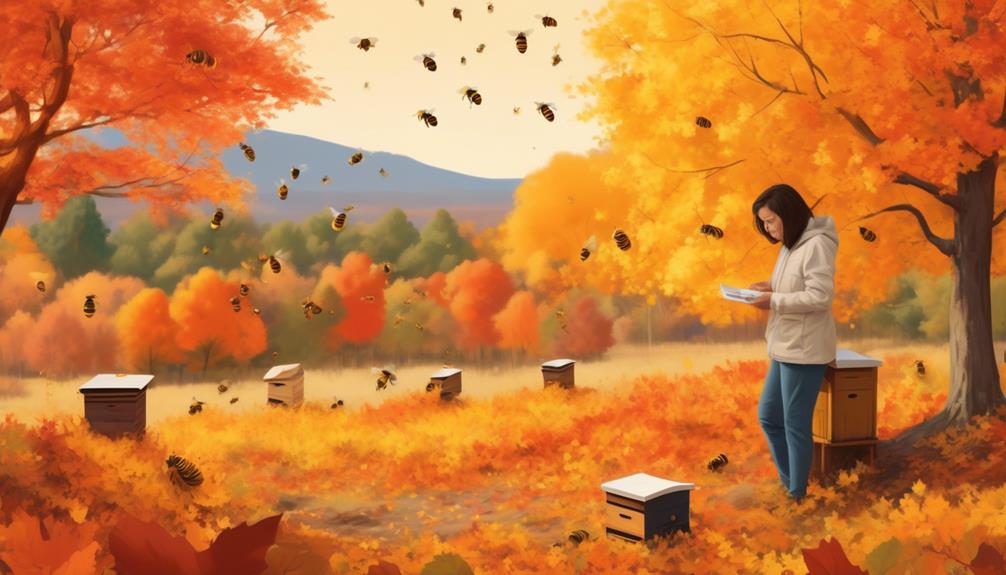
Navigating the heightened aggression of bees in the fall requires understanding their behavior and implementing careful strategies to avoid triggering their protective instincts. It's essential to remember that bees aren't naturally aggressive but are predisposed to defend their hive, especially during this season when their resources are dwindling.
You should avoid wearing bright colors or floral prints, as bees are attracted to these, mistaking them for flowers. Similarly, steer clear of strong scents, including perfumes, as they can draw bees to you. Rapid movements can also provoke bees, so when in their vicinity, it's best to move slowly and calmly.
If a bee approaches you, don't swat at it. This could incite the bee to sting. Instead, gently blow it away or calmly leave the area.
If you encounter a swarm or a hive, maintain a safe distance. Disturbing a hive may result in a defensive attack from multiple bees.
Tips for Safely Navigating Bee Season
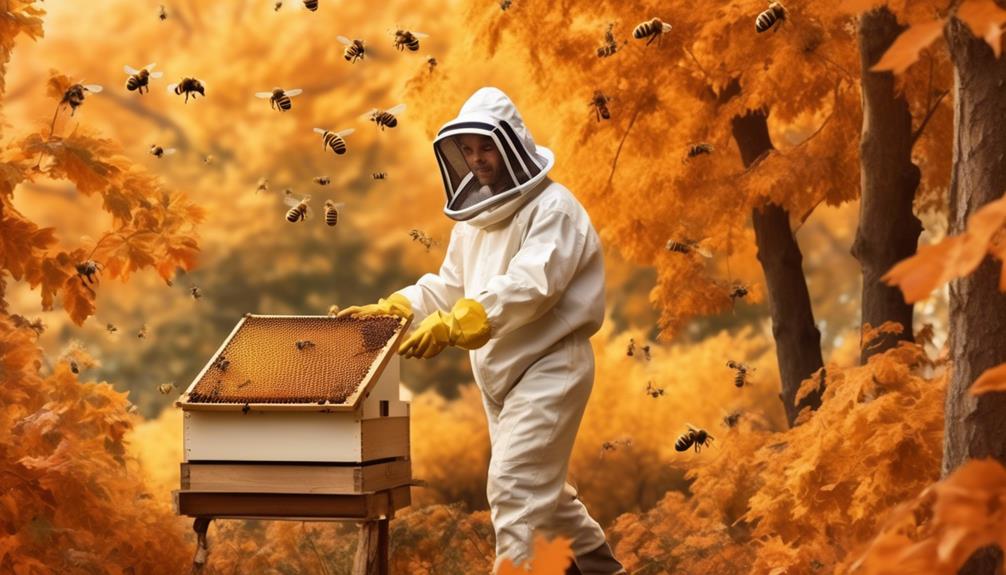
To safely buzz through bee season, you'll need to arm yourself with effective strategies and a deep understanding of bee behavior. Bees are more prone to aggression during autumn due to their survival instincts kicking in; they're protecting their colonies and hoarding food for the winter.
Avoid wearing bright, floral patterns that might attract bees. They're drawn to anything that resembles a flower, so try wearing neutral colors. Strong fragrances, too, can attract bees, so it's best to go scent-free. Furthermore, don't make sudden movements near a hive or a bee; this can trigger their defense mechanisms, causing them to sting.
If you encounter a bee, don't swat at it. Instead, calmly move away. If stung, remove the stinger immediately to reduce the amount of venom entering your system. Use a credit card or flat object to scrape it out; don't pinch, as this can release more venom.
Lastly, it's crucial to understand that bees aren't out to get you. They're essential to the ecosystem and are typically non-aggressive unless provoked. Navigate bee season with respect and caution, and you'll find there's nothing to fear.
Frequently Asked Questions
What Types of Bees Become Aggressive in the Fall?"
You're likely dealing with honey bees and yellow jackets in the fall. These types become more aggressive as they're preparing for winter.
Honey bees are defending their hive's resources, and yellow jackets are nearing the end of their life cycle, which makes them more desperate for food. It's not personal, they're just doing what's necessary for survival.
Be careful not to provoke them, and you'll decrease your chances of getting stung.
How Does a Bee's Diet Change During the Autumn Months?"
In autumn, you'll notice a bee's diet undergoes a significant change. They're no longer gathering nectar from flowers as most have stopped blooming. Instead, they're more focused on building up their honey stores for winter.
They'll eat more of their own honey, which is rich in sugars and nutrients. This shift in diet helps them prepare for the colder months when food sources are scarce.
They also consume pollen for protein, vital for the next generation's development.
Are There Any Specific Geographical Areas Where Bees Are Particularly Aggressive in the Fall?"
You're asking if certain geographical locations cause bees to be more aggressive in autumn.
It's not so much the location, but the climate and food availability that affect their behavior.
In areas with harsh winters, bees can become more protective of their hive and food stores in the fall.
Conversely, in milder climates where food is plentiful year-round, bees may not exhibit such aggressive behavior.
What Are the Potential Health Risks Associated With Bee Stings in the Fall?"
You're at risk of various health issues when stung by bees in fall. You could experience allergic reactions, ranging from mild irritation to severe anaphylaxis. The sting's venom may cause local pain, swelling, redness, and itching.
Multiple stings might lead to nausea, vomiting, diarrhea, dizziness, or even a sharp drop in blood pressure. Always seek immediate medical help if you're stung multiple times or show signs of a severe allergic reaction.
Can Certain Activities or Behaviors Provoke Bees More in the Fall Than in Other Seasons?"
Yes, certain activities can provoke bees more in the fall.
You're likely to stir up bees if you're near their hive, especially if you're making a lot of noise or moving quickly.
It's also important to avoid wearing bright colors or floral patterns, as bees are drawn to these.
Furthermore, if you're eating or drinking something sweet, you're more likely to attract bees.
Conclusion
You've seen how seasonal changes, particularly fall, impact bee behavior, leading to increased aggression. Understanding this is key to avoiding unnecessary stings.
Remember, it's crucial to respect their space, especially during autumn when their survival instincts kick in. Utilize the tips provided to safely navigate bee season and coexist peacefully.
The more we know, the better we can cohabitate with these vital pollinators.

